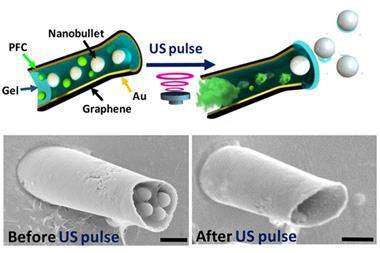Scientists in the US have developed a microrocket, thinner than a human hair, which has the first ever built-in delayed ignition system.
Catalytic microrockets, which have possible applications such as environmental clean-up, neutralising chemical weapons, drug delivery and cancer treatment, are tiny tubes with an interior catalyst lining. When placed in a liquid containing a suitable fuel like hydrogen peroxide, the catalytic reaction inside the tube generates gases, which escape from the end of the tube propelling it forward at relative super speed: up to 400 body lengths per second.
Most microrockets start running the instant they come into contact with fuel, or they require an external stimulus such as light. Joseph Wang and his team at University of California, San Diego, US, have now developed catalytic microrockets with a delayed ignition system. Placed in gastric acid or seawater containing peroxide fuel, the microrockets spontaneously blast off up to 28 minutes later.
Lined with a copper–platinum alloy, the tubes sit dormant in the fuel solution, which slowly corrodes the copper to reveal the active platinum catalyst. As the platinum becomes exposed, the chemical reaction begins, ‘igniting’ the rocket, which then speeds up as more copper corrodes away. The time to ignition could be adjusted by varying the composition of the alloy, fuel concentration, salt concentration or pH.
References
This article is free to access until 25 November 2016
A Jodra et al, Chem. Comm., 2016, DOI: 10.1039/C6CC06632A






















No comments yet